
Ancient Colorado River Flowed Backwards
An ancient river roughly the size of today's Colorado River once flowed from California's Mojave Desert northeast through Arizona and Utah, in the opposite direction of the modern Colorado River, a new study finds.
It has been named the California River, due to its area of origination.
Steven Davis, a post-doctoral researcher at the Carnegie Institution of Washington, in Washington D.C., and fellow researchers discovered the ancient river system by comparing sedimentary deposits in Utah and southwest Arizona. By analyzing different types of uranium and lead atoms in sand grains made of the mineral zircon, the researchers were able to determine that the sand at both locations wasn't local, and that instead it came from igneous bedrock in the Mojave region of southern California.
In Utah, the deposits from this river — known as the Colton Formation by geologists — formed a delta, where the river had emptied into a large lake. These deposits are more than 400 miles (700 kilometers) to the northeast of their source in California.
"The river was on a very similar scale to the modern Colorado-Green River system," Davis said, "but it flowed in the opposite direction."
The modern Colorado River's headwaters are in the Rocky Mountains, flowing southeast to the river's mouth in the Gulf of California.
The deposits found in the Colton Formation are around 55 million years old. While other researchers have speculated that older rivers may have carved an ancestral Grand Canyon around this time, long before the Colorado began eroding the present canyon less than 20 million years ago, Davis sees no evidence of this.
Get the world’s most fascinating discoveries delivered straight to your inbox.
"The Grand Canyon would have been on the river's route as it flowed from the Mojave to Utah, he said."It stands to reason that if there was major erosion of a canyon going on we would see lots of zircon grains from that area, but we don't."
The California River likely met its end as the Rocky Mountains rose and the northern Colorado Plateau tilted, reversing the slope of the land surface and the direction of the river's flow to create the present Colorado-Green River system. But researchers have still not determined when the change occurred.
"The river could have persisted for as long as 20 million years before the topography shifted enough to reverse its flow," David said.

